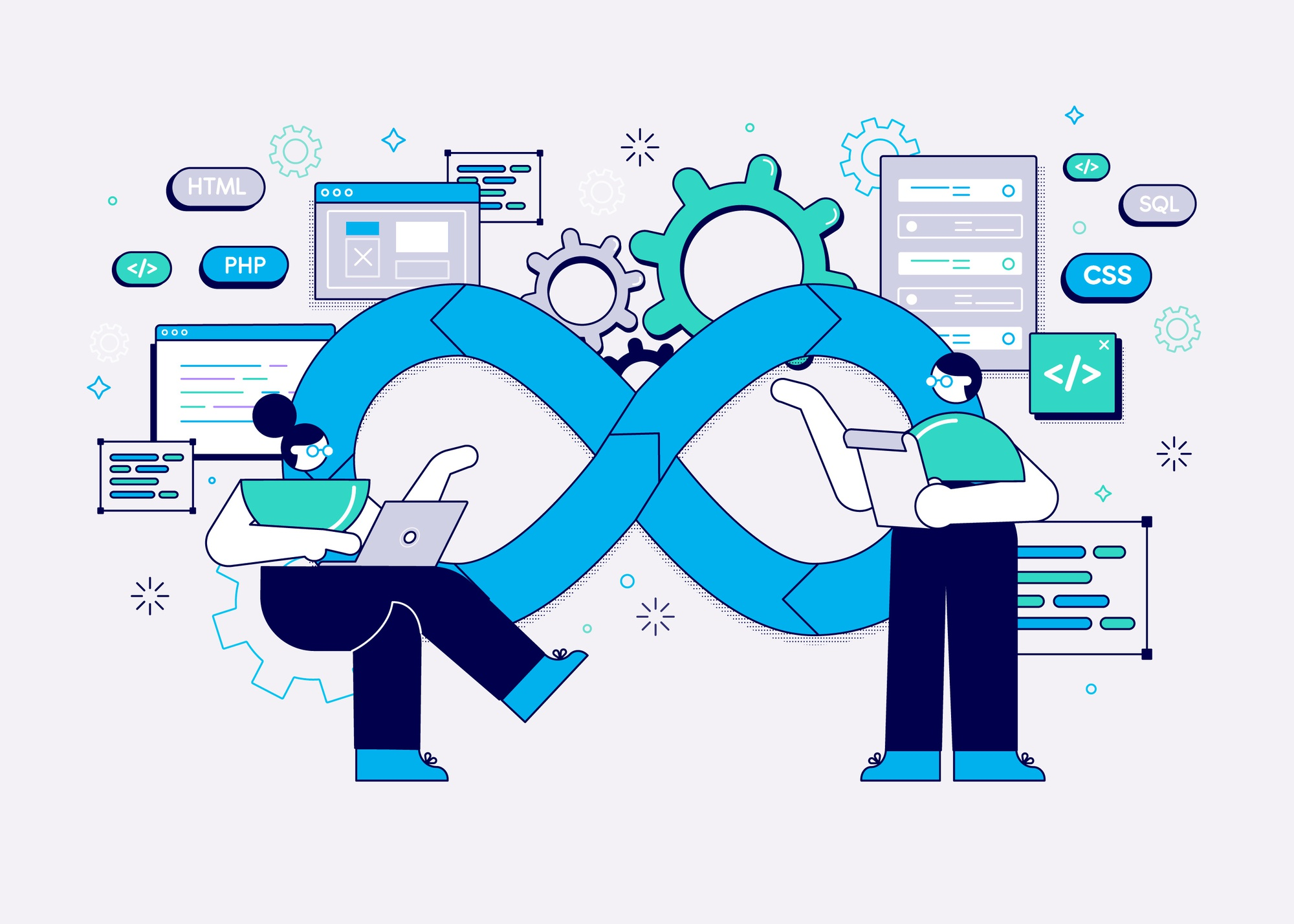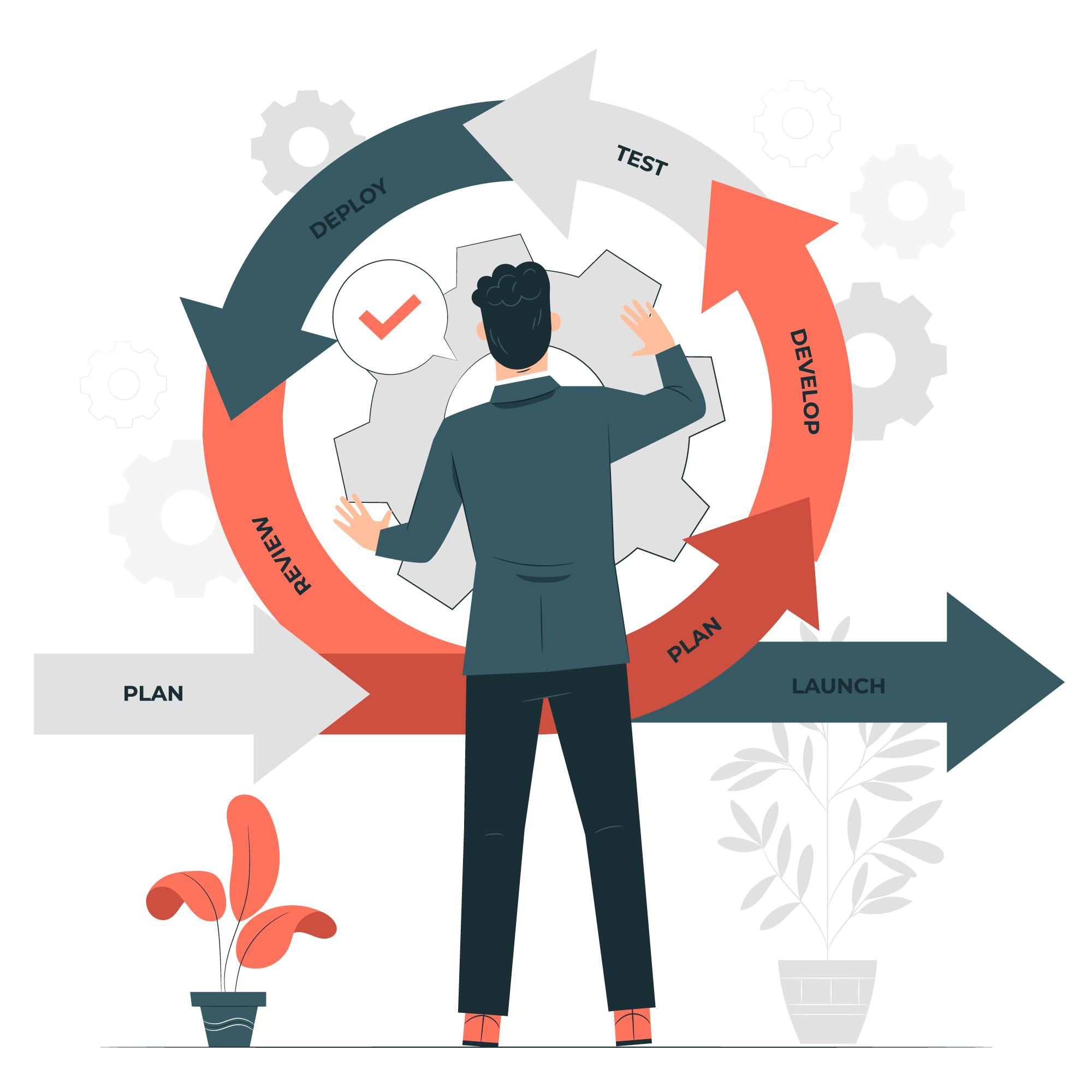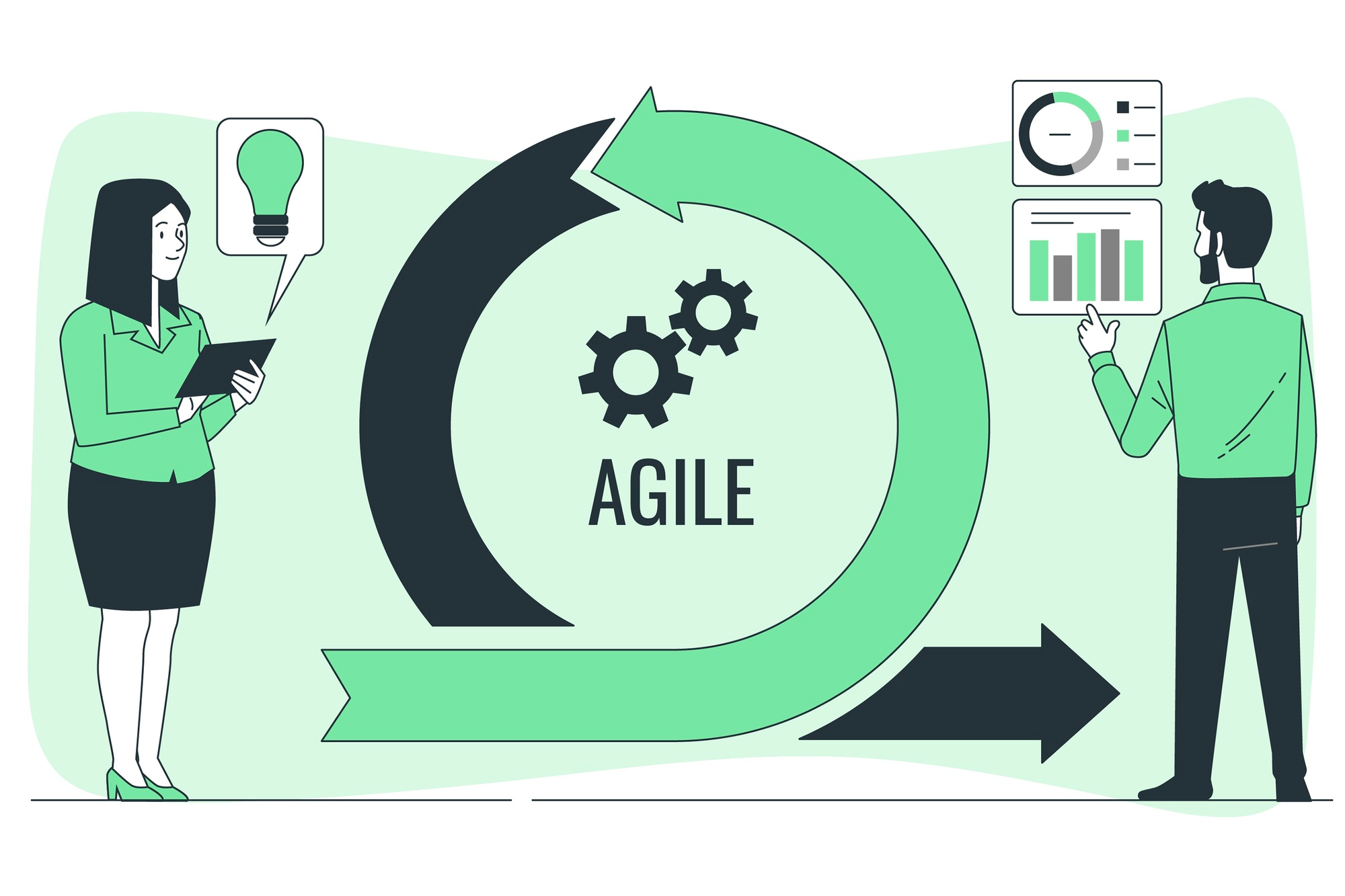Agile project management is a dynamic approach that has revolutionized software development plans.
In today’s fast-paced and ever-evolving digital landscape, traditional project management methodologies often fall short of delivering successful outcomes.
Agile project management, on the other hand, provides a framework that promotes flexibility, collaboration, and iterative development.
In this article, we explore the various aspects of agile project management and its significance in software engineering projects.

What Is Agile Project Management?
Imagine you’re building a sandcastle on the beach with your friends.
Now, agile project management is like having a plan, but being open to changes and working together in a flexible and collaborative way. Instead of building the entire sandcastle all at once, you break it down into smaller steps.
You gather feedback from your friends along the way, making adjustments and improvements as needed. This allows you to build the sandcastle faster, make it even better, and keep everyone involved and happy.
So, in simple terms, agile project management focuses on being adaptable, working together, and delivering great results in a fun and collaborative way!

Overview of Project Management
In the world of software development, project management plays a crucial role in ensuring successful outcomes. Whether it’s building a mobile app, creating a website, or developing complex software systems, effective project management methodologies are essential.
In this section, we will explore an overview of project management, comparing traditional methodologies with the agile approach.
By understanding the key differences and benefits, we can appreciate how agile project management has revolutionized the way software engineering projects are executed.
Let’s delve in.
Traditional Project Management Methodologies
This project management methodologies, such as the waterfall approach, follow a linear and sequential process. They involve extensive planning, documentation, and a focus on adhering to predefined project requirements.
However, this rigid approach often hampers adaptability and inhibits collaboration within development teams.
Agile Project Management Methodology
Agile project management, in contrast, embraces change and flexibility throughout the development process. It emphasizes collaboration, iterative development, and delivering incremental value to customers.
Agile project management methodologies break down projects into smaller, manageable iterations called sprints, allowing for continuous feedback and adaptation.

Key Differences Between Traditional and Agile Project Management
The key differences between traditional and agile project management lie in their approach to change, collaboration, and customer satisfaction.
While traditional methodologies rely on comprehensive documentation and contract negotiations, agile frameworks prioritize customer collaboration, adaptive planning, and working software over comprehensive documentation.
Agile Methods in Software Development
Imagine a world where software engineering projects are dynamic, adaptable, and foster a true sense of collaboration. Agile software development methodologies have turned this vision into a reality. Let’s find out how.

Agile Manifesto and Principles
The Agile Manifesto serves as the guiding philosophy for agile frameworks. It emphasizes four key values:
Individuals and Interactions over Processes and Tools: Agile frameworks prioritize the collaboration, communication, and synergy among team members over rigid processes and tools.
Working Software over Comprehensive Documentation: Agile frameworks focus on delivering tangible software solutions that meet customer needs rather than extensive documentation that may not add direct value.
Customer Collaboration over Contract Negotiation: Agile frameworks promote active involvement and collaboration with customers throughout the development journey, ensuring that the final product meets their expectations.
Responding to Change over Following a Plan: Agile frameworks embrace change and flexibility, allowing teams to adapt to evolving requirements and market conditions.
Scrum Methodology
Scrum is one of the most popular agile frameworks used in application development. It involves a cross-functional team that collaboratively works on a project, following a set of predefined roles and ceremonies.
The Scrum team comprises a Product Owner, Scrum Master, and Development Team, each responsible for specific aspects of the project. Agile planning, execution, and product backlog management are essential components of the Scrum methodology.
Kanban Methodology
Kanban is another agile approach that visualizes the flow of work using a Kanban board. It promotes a continuous and steady workflow by limiting work in progress and emphasizing collaboration and transparency. Kanban enables teams to visualize bottlenecks, identify areas for improvement, and optimize the development journey.
Extreme Programming (XP)
Extreme Programming (XP) is an agile methodology that places a strong emphasis on engineering practices and teamwork. It advocates for continuous integration, test-driven development, pair programming, and regular customer feedback. XP enables development teams to deliver high-quality software while promoting collaboration and adaptability.
Lean Software Development
Lean software development draws inspiration from lean manufacturing principles to eliminate waste and optimize value delivery. It focuses on creating value for the customer, continuous improvement, and reducing unnecessary work. Lean application development promotes a culture of efficiency and responsiveness to customer needs.
Benefits of Agile Project Management
Agile project management offers numerous benefits that contribute to the success of software engineering projects. These benefits include:

Increased Efficiency and Collaboration
By promoting iterative development and cross-functional collaboration, agile frameworks enhance development team productivity and efficiency.
Agile groups can quickly respond to changing requirements, resolve issues, and make informed decisions, leading to higher-quality deliverables.
Early and Continuous Delivery of Working Software
Agile projects prioritize the delivery of working software at regular intervals. This approach allows customers to provide feedback early in the development journey, ensuring that the end product aligns with their expectations. Continuous and early delivery mitigates the risk of developing software that doesn’t meet customer needs.
Customer Satisfaction and Collabration
Agile frameworks foster close collaboration between development groups and customers.
Customer involvement throughout the project enables a deep understanding of their requirements, resulting in a product that better satisfies their needs. By valuing customer collaboration, agile project management ensures customer satisfaction.
Adaptability to Changing Requirements
Agile project management methodologies are designed to embrace change. Rather than adhering rigidly to initial requirements, agile groups welcome and accommodate evolving customer needs. This flexibility enables teams to pivot quickly, seize new opportunities, and respond to market demands effectively.
Continuous Improvement and Iterative Development
The iterative nature of agile frameworks enables continuous improvement. Agile groups reflect on their work at the end of each sprint and incorporate feedback into subsequent iterations.
This approach fosters a culture of learning and empowers teams to deliver higher-quality software with each iteration.
Empowerment of Self-Organizing Teams
Agile project management empowers self-organizing teams to make decisions and take ownership of their work.
By eliminating unnecessary bureaucracy and hierarchical constraints, agile frameworks unleash the creative potential of development team members and foster a collaborative work environment.
Technical Excellence and Good Design
Agile methods prioritize technical excellence and good design practices. By investing in code quality, automated testing, and persistent integration, agile groups ensure a robust and maintainable software solution. It forms the foundation for delivering value to customers consistently.
Implementing Agile Project Management
Applying agile project management requires a thoughtful and well-executed approach. In this section, we will explore the key aspects of implementing agile project practices and methodologies. By understanding the principles and strategies behind agile implementation, teams can effectively embrace agility and reap its benefits.

Agile Project Management Practices
To successfully implement agile project management, it’s crucial to adopt agile practices that promote collaboration, transparency, and continuous development. These practices include:
Cross-functional Teams: Agile project management encourages the formation of cross-functional teams comprising individuals with diverse skills and expertise. This promotes collaboration, knowledge sharing, and a collective sense of responsibility.
Iterative Development: Agile teams work in short iterations or sprints, focusing on delivering small, valuable increments of the project. This iterative approach allows for quick feedback, flexibility, and the ability to adapt to changing requirements.
Daily Stand-up Meetings: Daily stand-ups, or daily scrums, are short and focused meetings where team members provide updates on their progress, discuss any obstacles, and plan their activities for the day. These meetings foster communication, coordination, and a shared understanding of project status.
Persistent Integration and Testing: Persistent integration involves merging code changes into a shared repository frequently, followed by automated testing. This practice ensures that code changes integrate smoothly, reduces integration issues, and facilitates faster delivery of operational software.
Agile Project Management Methodologies
Selecting the right agile methodology for a project is crucial. Each project has unique requirements, team dynamics, and constraints that may influence the choice of methodology.
Agile frameworks and tools, such as Scrum or Kanban boards, provide structure and support for applying project management practices effectively.

Selecting the Right Agile Methodology for the Project
Consider factors such as project size, complexity, team composition, and customer requirements when selecting an agile methodology. Scrum, Kanban, Extreme Programming, or a combination of these methodologies can be tailored to suit specific project needs.
Agile Processes and Project Scope
Agile project management methodologies typically involve defining a project scope that allows for iterative development and incremental value delivery.
Agile processes, such as agile planning, backlog grooming, and retrospectives, enable efficient collaboration and continuous development.
Managing Agile Projects and Project Teams
In agile project management, the role of the project manager shifts from a traditional command-and-control approach to a facilitator and servant leader. The project manager supports the team, removes impediments, and ensures effective collaboration and communication within the team and with stakeholders.

Collaboration with Project Stakeholders
Successful agile project management relies on active collaboration with project stakeholders, including customers, end-users, and other relevant parties.
Regular feedback and open lines of communication ensure that the project remains aligned with stakeholder expectations throughout the development journey.
Agile Project Management Approach
Agile project management is more than just a set of practices—it’s a mindset and approach that permeates every aspect of the project. In this section, we will delve into the key elements of the agile project management approach. By understanding these aspects, project teams can effectively harness the power of agility to drive success.
Agile Processes and Project Performance
Agile processes play a vital role in managing project performance and ensuring successful outcomes. These processes include:
Backlog Refinement: Agile teams regularly review and refine the product backlog, ensuring that it contains a prioritized list of requirements and user stories. This allows for effective planning and continuous alignment with customer needs.
Sprint Planning: This planning involves determining which items from the product backlog will be worked on in the upcoming sprint. The team collaboratively defines sprint goals, estimates effort, and commits to delivering specific increments of value.
Daily Stand-ups: Daily stand-up meetings, also known as daily scrums, are short and focused gatherings where team members share progress, discuss any challenges, and align their efforts for the day. These meetings promote transparency, coordination, and quick issue resolution.
Retrospectives: Retrospectives provide an opportunity for the team to reflect on the recently completed sprint. By discussing what went well, what could be improved, and potential action items, the team can continuously learn and enhance their performance.
Continuous Integration and Delivery
Continuous integration and delivery are fundamental principles of agile project management. By integrating code changes frequently and automating testing and deployment, development groups can ensure that the software remains in a deployable state, reducing integration issues and facilitating rapid delivery of new features.

Customer Collaboration over Contract Negotiation
Agile project management prioritizes customer collaboration and involvement throughout the development process. This approach enables customers to actively participate in shaping the product, providing feedback, and ensuring that their requirements are met.
Collaboration fosters a sense of shared ownership and promotes customer satisfaction.
Collaboration and Communication within Agile Teams
Clear and effective communication is essential within agile teams. Daily stand-up meetings, sprint planning sessions, and regular retrospectives facilitate collaboration, enable quick problem-solving, and ensure that team members are aligned and working towards a common goal.
Agile Values and Principles in Project Management
The agile values and principles outlined in the Agile Manifesto should guide project management decisions and practices. Emphasizing individuals, interactions, and responding to change creates an environment conducive to successful agile project management.
Conclusion
In a nutshell, agile project management has completely transformed the software development landscape. It’s all about being flexible, collaborative, and iterative.
And let me tell you, the benefits are fantastic! We’re talking increased efficiency, early delivery of working software, happy customers, adaptability to change, continuous improvement, and empowered teams.
To make it work, you’ve got to implement those agile practices, pick the right methodology that suits your project, and truly embrace those agile values. It’s all about fostering innovation, adapting on the go, and keeping your customers at the heart of it all.
So, in a friendly reminder, agile project management is the secret sauce to boosting efficiency, collaboration, and achieving incredible results in the software engineering realm. Embrace the agility, my friend, and watch your projects soar to new heights in this ever-evolving industry!

People Also Ask (FAQs)
What is agile project management, and how does it differ from traditional project management?
Agile project management is an iterative and collaborative approach to managing software engineering projects. It emphasizes flexibility, adaptability to change, and customer collaboration. Unlike traditional management, which follows a linear and sequential process, agile project management allows for continuous feedback, shorter development cycles, and the delivery of operational software in increments.
What are the key benefits of implementing agile project management in software development projects?
Applying agile project management offers several benefits, including increased efficiency and collaboration among team members, early and continuous delivery of operational software, enhanced customer happiness and collaboration, adaptability to changing requirements, continuous development and iterative development, empowerment of self-managing teams, and a focus on technical excellence and good design practices.
Which agile methods are commonly used in software engineering projects?
Some commonly used agile methods in software engineering projects include Scrum, Kanban, Extreme Programming (XP), and Lean Software Development. These methodologies provide frameworks and practices that support iterative development, collaboration, and adaptability.
How do agile project management practices foster collaboration within development teams?
This project management practices promote collaboration within development teams by encouraging frequent communication, transparency, and self-organization. Regular meetings, such as daily stand-ups and sprint planning sessions, facilitate information sharing and coordination. Additionally, agile methodologies emphasize cross-functional teams and empower team members to make decisions collectively.
How can agile project management enhance efficiency in software engineering projects?
Agile project management enhances efficiency in software engineering projects by promoting iterative development, persistent integration, and early feedback. By breaking down projects into smaller, manageable iterations, teams can focus on delivering incremental value. Regular feedback loops enable quick adjustments, issue resolution, and the identification of bottlenecks, ultimately streamlining the development process.
How does agile project management address changing requirements during the software development process?
Agile project management embraces changing requirements as a natural part of the software development process. Instead of rigidly adhering to initial requirements, agile methodologies allow for flexibility and adaptation. Regular client collaboration and feedback loops enable teams to incorporate changes effectively, ensuring that the final product meets customer needs and expectations.



